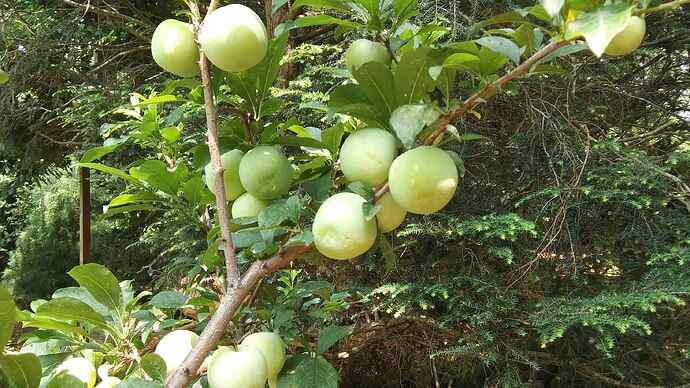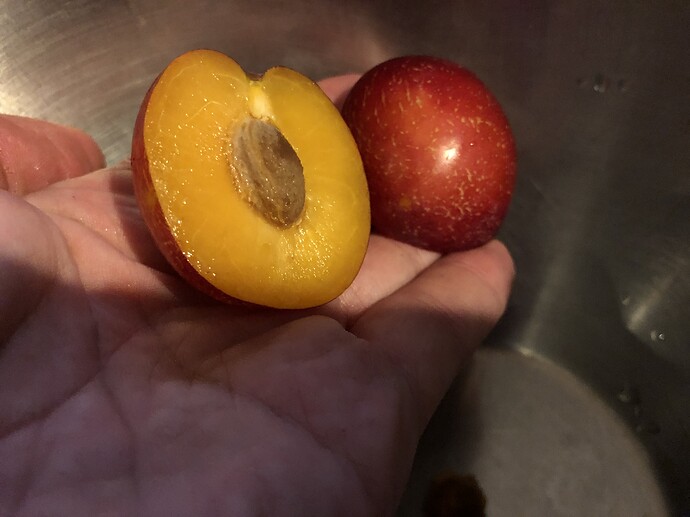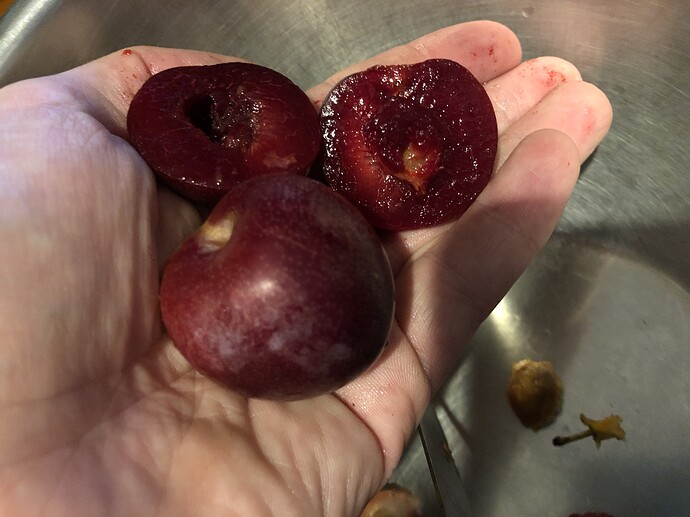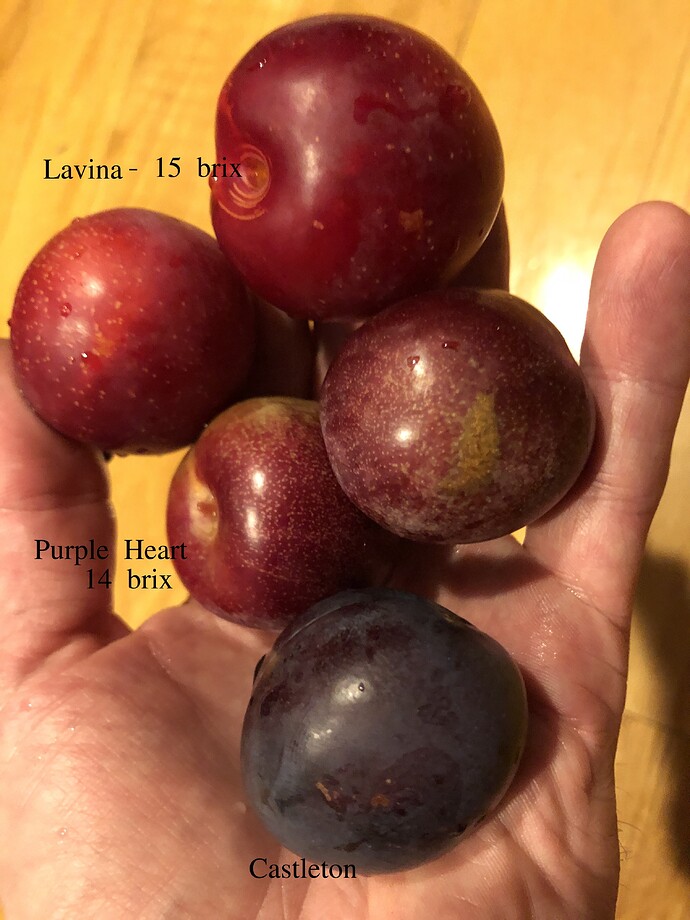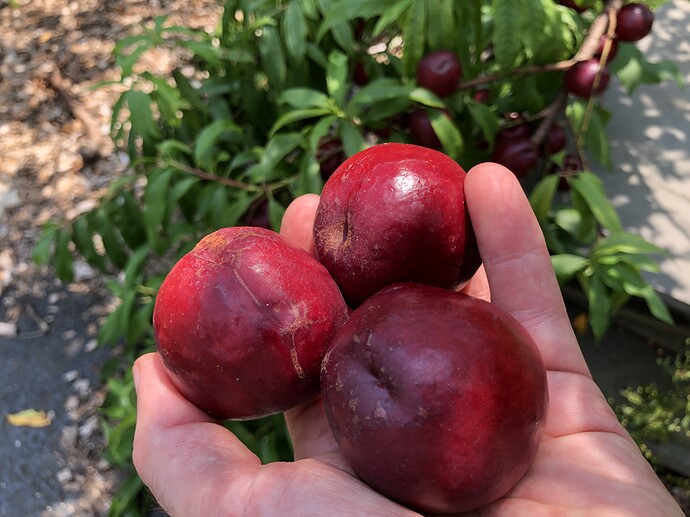Plouts flower early here.
Flavor Supreme, Flavor King and Dabble Dandy are on the same tree. Very little fruit from Flavor Supreme (as usual but delicious fruit). Flavor King and Dapple Dandy have plenty.
Dapple Dandy:
In my location the temperatures are sometimes 50f or lower when pluots are in bloom. The bees like 55f so some days or most days there is no pollination. This year temperatures were mostly 55f to 60f during pluot bloom so pollination was ok. Santa Rosa plum pollination was good but just a few days later temperatures dropped and Methley had poor pollination. All other fruit trees did very good.
We had a rainy and cloudy day yesterday. I picked 3-4 Early Magic today. They were not sweet yet. Brix was still about 12. Mine is very productive.
@danzeb - your pluots look nice. Wish my fake Jefferson was a pluot.
I measured a bigger fully ripe one today and it hit 17. That is all I need from a J. plum and EM has plenty of acid kick and nice texture- fairly meaty. I hope yours get there, but plums shouldn’t be as brix challenged by too much water as peaches IME. But how do you ever really know anything it the fruit growing business?
Same thing here, only my Flavor Grenades are big cracked messes. Flavor King is on a hard to reach graft so I never got around to thinning it- it’s spaced like your photo, more or less. Of course, even on plum trees I made every effort to adequately thin, I failed. With peaches, apples and nects I only get it done by coming back 3 times. The 3rd is the charm.
After the 16, I got a 14 and 17. Then today, I got a couple 15’s. Not bad, but this is only among the darker blushed ones. The slightly blushed ones are only around 12. I’ll wait on picking them, but the darker ones are ready, even though they are still firm.
It looks like Purple Heart is close to ripe as well. I picked a few of the darkest ones and was surprised by the inside color. They are a bit smaller and milder than Lavina, but still tasty at ~14 brix. Grafted from Scott in 2015, it is the last part of my Laroda tree. I removed the rest as it was badly affected by black knot. The Purple Heart had quite a bit of knot as well, but I wanted to get a crop out of it (Laroda didn’t have that much set, so it was an easy decision to cut the rest of the tree out). Once the plums are picked, I’ll try to figure out if I can save it.
The Castleton was soft, but that it because it had started to rot on one side, not because it was ripe…
My Silver Gem have a red tinge to their flesh, but are still pretty sharp. I checked the brix on one today and it was only 8-9. The graft is on the NW side of the tree and the weight of the fruit has pulled the branch pretty low.
I had an AU Rosa. The biggest disease problem was black knot, which eventually caused the removal of the tree. Lavina has been the most resistant plum I’ve had. It was right near other badly impacted trees and only has a couple spots.
It amazes me that you are only now getting ripe Silver Gems and have ripe Lavinas. Your world is upside down or mine is.
If you are picking SG’s with only 8-9 brix that have any softness and ripen within a day, all the more so. I have to admit that the range on my own property is significant. Soil that holds water better seems to produce lower brix fruit, which is one of two reasons I decided to grow my orchard in a new place. The Hillside with the first sun of the day and the firs to dry out after a soaking rain.
Nevertheless, it doesn’t affect the brix of plums much. My Early Magic seem all to be in the 14-17 range.
Lavina looks like a good plum to try out at my location. Thanks
I grew Inca which also is a small yellow plum similar to Lavinia. Not as early. I prefer Inca over Lavina. Personal taste varies. Inca was introduced in 1919 by Burbank. It faded from popularity. The people at LE Cooke found a tree and tried them. So in 2011 LE Cooke reintroduced them. I had a graft and lost the tree the graft was on. Once my new trees get bigger I certainly will be adding it back.
Hi Norman .
Sorry but we started talking about other things and I forgot to answer your question .
You were asking me , about good pollinating plum varieties for pluots and Japanese plum varieties.
Obviously they have to meet several essential requirements:
- Flowering date, early and media
- High floribundity index
- long period of floribundity
- High compatibility in pollination of pluots and Japanese plums
Based on these premises, and after having checked it in my orchard, the three varieties that are best suited to cover a wide range of pollination are these three (coincidentally I coincide with the criteria of Orero nurseries, which is a specialized plum nursery)
- Santa Rosa
- Golden Japan
- Friar
In this graph, you can see that they are recommended for being excellent polivalent pollinators (in the graph, good polyvalents pollinators are marked with a red asterisk).
With those three plum trees in your orchard, unless it is a year of copious rains during the flowering period, you have guaranteed , the pollination of all varieties of pluots and Japanese plums .
Regards
Jose
Thank you @Jose-Albacete ,
I will ad those 3 varieties as soon as I find them. Pollination seems to be an huge issue with jap. plums/pluots in my climate. We tend to have long springs with late freezes and cold periods well into may.
Orero nursery also has a nice maturity chart on their website.
The paper @alan provided also is very interesting. Santa Rosa is recommended as an “universal” pollinizer too. Does anybody know if Weeping Santa Rosa shares this trait being a good universal pollinizer?
Best Regards
Yes, according to Dave Wilson Nursery.
Reading through this thread.
Ison’s lists it and shows zone 6-9 and 300-400 chill hours then a bit further down the page it’s listed as 750 hours.
The few other sites I’ve found callboy a zone 5-8, so I assuming the 300-400 is a mistake.
It’s originally from Georgia which I believe is zone 7-8b. I’m betting on low chill.
It will work for you, early blooming though. I’ve had since 2010 and it will produce well if not frozen out.
You aren’t that far for me but you definitely get more chill.
The late March freeze here this year was unusual. Of course it could happen again next year… Or not for another 20.
Thanks for the reply.
Isnt it suposed to be an “aprium” like the other biricocolo?
Zaiger, in their relentless focus on branding, copyrighted the word pluot so Spring Satin had to settle for the less memorable category of Aprium. Perhaps it is the more appropriate name because, to my palate, it is the only fruit I’ve ever eaten that clearly has traits of both apricot and plum. With the Zaiger creations you have to take them at their word as their textures and tastes are nothing but plum in my mouth, at least. I suspect their red-flesh varieties have a lot of Elephant Heart in their genetics. They really aren’t that much of an improvement on that queen of J. plums and share a similar high vulnerability to untimely hard frosts or even late winter single digit temps.
The gift of pluots is not so much the marriage of cot and plum qualities as creating a plum that gets very sweet while still firm. Spring Satin declares its cot DNA in the texture of its skin and, to a lesser degree its flesh.
So far, it has been a pretty shy bearer for me, but even a meager crop of such an unusual, early, and delicious fruit warrants the space it takes in my orchard in NYS. It doesn’t, however, attain sweetness while still firm. It looks ripe weeks before it reaches sweetness which occurs when the flesh gives to a bit of pressure.
Are the words plumcot, pluot, aprium and others all copyrighted?
What you mean is that the natural dasycarpa hybrids are much more close to what a real flavor mix of apricot and plum realy is?
Zaiger trademarked Pluot and Aprium. Plumcot, Apriplum, and whichever one I’m forgetting are words anyone can use.
